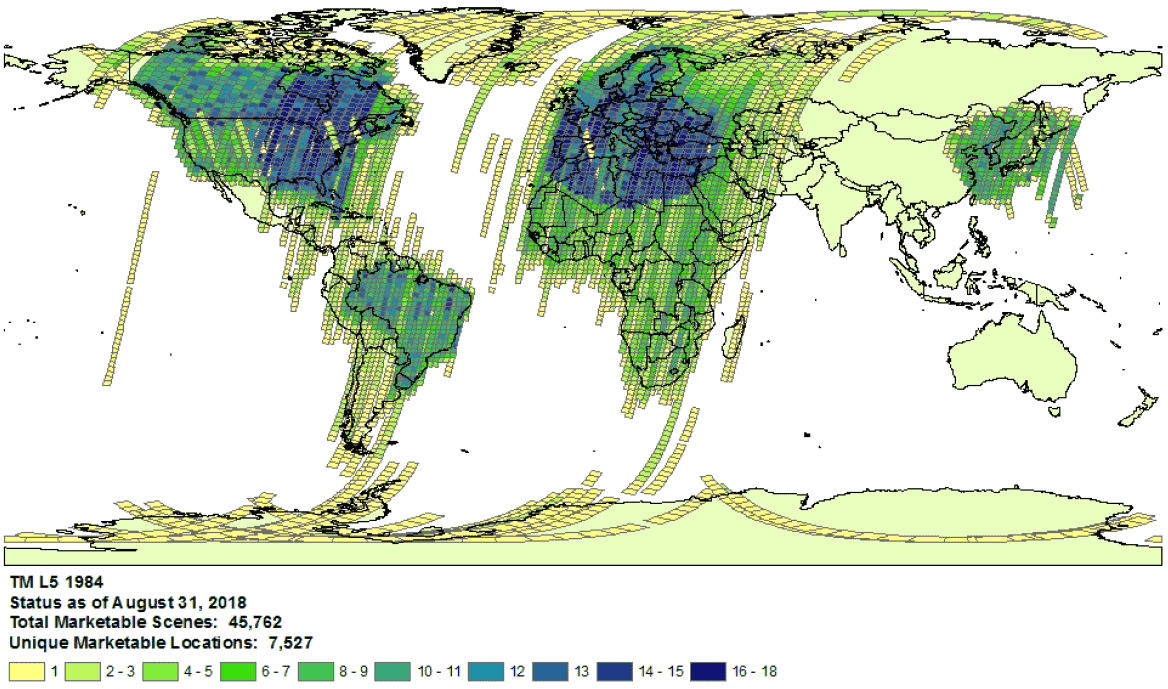هدف این سند این است که به شما کمک کند تعیین کنید آیا یک دارایی در کاتالوگ داده موتور زمین (در حال حاضر Landsat، Sentinel و MODIS) وجود ندارد یا خیر.
مراحل ذکر شده شرح می دهد که چگونه:
دارایی های موجود را در کاتالوگ های Earth Engine و ارائه دهندگان بررسی کنید.
جمع آوری اطلاعات مورد نیاز برای ارسال تاییدیه یک دارایی مفقود به تیم داده Earth Engine.
موارد رایجی که باید در نظر بگیرید
سطح پردازش : ممکن است همه تصاویر برای یک سطح پردازش یا محصول معین در دسترس نباشند. به عنوان مثال، تصاویر با کیفیت پایین ممکن است به بالاترین سطح پردازش نشوند.
پوشش مکانی - زمانی : یک آهنگ منظم برای هر مجموعه داده تضمین نشده است. تغییر در وظایف حسگر، کیفیت تصویر و مدیریت بایگانی میتواند بر در دسترس بودن دادههای ارائهدهنده تأثیر بگذارد.
 نمونه ای از پوشش مجموعه لندست 5 برای سال 1984.
نمونه ای از پوشش مجموعه لندست 5 برای سال 1984.
- انتخاب ارائهدهنده : دادهها در کاتالوگ داده موتور زمین از یک ارائهدهنده انتخابشده در هر مجموعه داده وارد میشوند. این امکان وجود دارد که ارائه دهنده یک آرشیو کامل ماموریت را ارائه ندهد. به عنوان مثال، مجموعه دادههای Landsat از بایگانی USGS دریافت میشوند، که مشخص است تصاویری از ایستگاههای دریافت خاص برای دورههای زمانی معینی از دست داده است (برای اطلاعات بیشتر به تلاش LGAC مراجعه کنید).
لندست
داده های Landsat از سازمان زمین شناسی ایالات متحده (USGS) دریافت شده است.
در دسترس بودن پوشش Landsat را برای زمان و منطقه مورد علاقه تأیید کنید.
جستجویی را در Earth Engine انجام دهید تا لیستی از همه دارایی ها را برای زمان و منطقه مورد علاقه دریافت کنید. مراقب باشید که هیچ دارایی به طور تصادفی در کد شما فیلتر نشده باشد. در اینجا یک نمونه اسکریپت آمده است. مطمئن شوید که مجموعه را با سطح و سطح پردازش مناسب وارد می کنید ( در مورد ساختار مجموعه لندست بیشتر بیاموزید).
به دنبال داراییهای گمشده بالقوه در کاتالوگ USGS Earth Explorer بگردید (راهنمای راهنما برای مراحل دقیق انجام جستجو و انتخاب مجموعههای داده را ببینید). مطمئن شوید که محصولات و سطوح پردازش مناسب را با هم مقایسه می کنید ( به ساختار مجموعه Landsat مراجعه کنید ). توجه داشته باشید که محصولات بازتاب سطحی فقط برای تصاویر Landsat با سطح پردازش L1TP تولید می شوند.
با ارسال یک بلیت با شناسه محصول ارائهدهنده و پیوندی به اسکریپت ویرایشگر کد موتور Earth که عدم وجود داراییها را تأیید میکند، شواهد دقیقی درباره داراییهای گمشده به اشتراک بگذارید.
نگهبان
دادههای Sentinel از سایت Copernicus Dataspace دریافت میشوند.
در دسترس بودن پوشش Sentinel را برای زمان و منطقه مورد علاقه تأیید کنید (به جزئیات ماموریت مراجعه کنید).
توجه : محصولات Sentinel-2 Level-2A فقط از مارس 2018 به طور سیستماتیک در بخش زمینی در اروپا تولید می شوند و تولید در دسامبر 2018 به سطح جهانی گسترش یافت (برای جزئیات بیشتر به راهنمای کاربر ESA مراجعه کنید). آنها در نهایت به عنوان بخشی از مجموعه 1 بازسازی خواهند شد.
جستجویی را در Earth Engine انجام دهید تا لیستی از همه دارایی ها را برای زمان و منطقه مورد علاقه دریافت کنید. مراقب باشید که هیچ دارایی به طور تصادفی در کد شما فیلتر نشده باشد. در اینجا یک نمونه اسکریپت آمده است. مطمئن شوید که مجموعه را با سطح پردازش مناسب وارد می کنید.
به دنبال دارایی های گمشده بالقوه در کاتالوگ کوپرنیک باشید.
با ارسال یک بلیت با شناسه محصول ارائهدهنده و پیوندی به اسکریپت ویرایشگر کد موتور Earth که عدم وجود داراییها را تأیید میکند، شواهد دقیقی درباره داراییهای گمشده به اشتراک بگذارید.
MODIS
دادههای MODIS از مرکز بایگانی فعال توزیعشده فرآیندهای زمین (LP DAAC) دریافت میشود.
جستجویی را در Earth Engine انجام دهید تا لیستی از همه دارایی ها را برای زمان و منطقه مورد علاقه دریافت کنید. مراقب باشید که هیچ دارایی به طور تصادفی در کد شما فیلتر نشده باشد. در اینجا یک نمونه اسکریپت آمده است. مطمئن شوید که محصول مورد نظر را وارد می کنید.
به دنبال داراییهای گمشده بالقوه در USGS Data Pool باشید که به Earth Engine اضافه نشدهاند. به پوشه مناسب بروید و آخرین دایرکتوری های موجود را شناسایی کنید.
مجموعه داده هایی که با "MOD" شروع می شوند در " Terra MODIS " هستند
مجموعه داده هایی که با "MYD" شروع می شوند در " Aqua MODIS " هستند
مجموعه داده هایی که با "MCD" شروع می شوند در " MODIS ترکیبی " هستند
مجموعه داده هایی که با "VNP" شروع می شوند در " S-NPP VIIRS " هستند
با ارسال یک بلیت با شناسه محصول ارائهدهنده و پیوندی به اسکریپت ویرایشگر کد موتور Earth که عدم وجود داراییها را تأیید میکند، شواهد دقیقی درباره داراییهای گمشده به اشتراک بگذارید.
